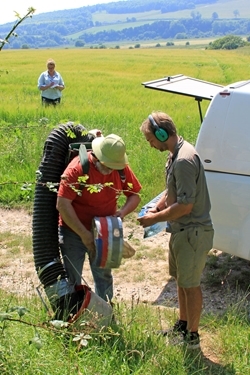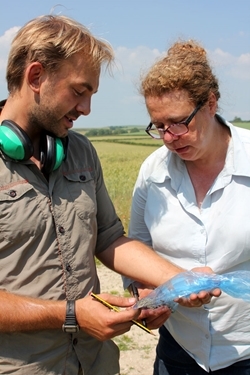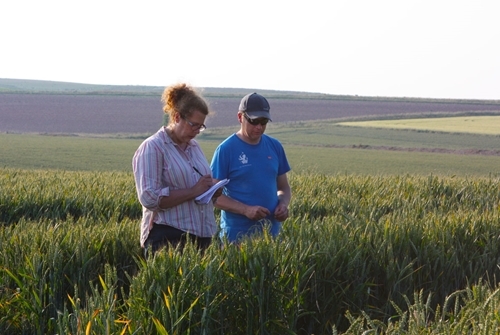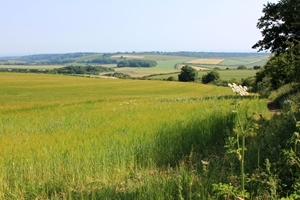By Jen Brewin, GWCT Writer and Research Specialist
 Every year, in the third week of June, a team of GWCT scientists travel to Sussex, to roam a large area of farmland stretching 11 miles across the South Downs. They are collecting data for the Sussex Study, a long-running project that is one of the cornerstones of the GWCT’s research. It all began in 1968 and has provided a wealth of important data on the impact of farming methods, policy and conservation techniques.
Every year, in the third week of June, a team of GWCT scientists travel to Sussex, to roam a large area of farmland stretching 11 miles across the South Downs. They are collecting data for the Sussex Study, a long-running project that is one of the cornerstones of the GWCT’s research. It all began in 1968 and has provided a wealth of important data on the impact of farming methods, policy and conservation techniques.
Each June, the team collects data on insects, arable plants and, later in September, on grey partridge productivity to maintain that long-term understanding, which is so critical to the value of this project. I was delighted to join them this week to better understand the work they do. It was a valuable experience, and quickly became clear that research scientists to do not like idle hands or having their photo taken when they put me to work collecting pit-fall samples.
To achieve consistency throughout the project, GWCT scientists return to the same locations in the same fields each summer. Here, they record the crop that is planted and whether there are any lost or new features, such as hedgerows and conservation headlands. Our senior entomologist, Steve Moreby, a Sussex veteran himself in his 36th year of monitoring, uses a D-Vac – a large, back-mounted vacuum that sucks up smaller and lighter invertebrates from the vegetation and soil surface.
 Meanwhile, in this same area, Julie Ewald, who is in charge of the Sussex Study, examines the plant life in amongst the crops, identifies which weeds are present, and looks at the health of the crop. Ryan Burrell assists and maps the habitats present across each farm. With each stop we build up a picture of insect and plant populations and farm management across the area. In a revisit to an original component of the study undertaken in the early 1970s, this year pit-fall traps are being used to collect larger species. This will help us to understand what beneficial insects are present, eating the pest species that can damage crops.
Meanwhile, in this same area, Julie Ewald, who is in charge of the Sussex Study, examines the plant life in amongst the crops, identifies which weeds are present, and looks at the health of the crop. Ryan Burrell assists and maps the habitats present across each farm. With each stop we build up a picture of insect and plant populations and farm management across the area. In a revisit to an original component of the study undertaken in the early 1970s, this year pit-fall traps are being used to collect larger species. This will help us to understand what beneficial insects are present, eating the pest species that can damage crops.
All this is hard work. Two days in a row of ten hours in the sun, lugging around a big, heavy, noisy, hot insect hoover. Maintaining concentration throughout when you are hot, sticky and tired is very difficult and draining. Despite the 30-degree heat, the team collected 100 samples, punctuated by some very dusty and sometimes difficult off-road driving.
Although not regularly appearing in the headlines, having nearly half a century of long-term monitoring is invaluable in allowing us to really understand the impact of what we do in the countryside, and how we can adjust our approach to support wildlife. This is demonstrated by the influence this study has had on significant aspects of the UK’s farmland policy. The success and longevity of the study would not have been possible without the patience of the farmers within the study area.

GWCT Head of GIS Julie Ewald with Hugh Passmore. Hugh farms at Applesham Farm, with
Chris Passmore. Chris has been involved with the Sussex Study since the beginning in 1968.
The trip showed the patience and attention to detail it takes to do this kind of fieldwork – what is really behind those scientific papers written up many months later. The dedication to come back every year. The perseverance to do all the necessary samples, even at the end of a long day, and therefore maintain the links in the chain of data year on year. The attention to detail to accurately log and index each sample correctly so that when it is processed weeks or months later it can be slotted into the complex jigsaw of data that gradually builds up. Not to mention the patience to calmly deal with the challenges of engines that won’t start, gates that are rusted shut (and communications team members that tag along!), while trying to keep some semblance of a sense of humour.
 Despite all this, there are rich rewards. The countryside there is beautiful. The skylarks and corn buntings are singing in the summer sun (thanks to Ryan for the tuition). In places, the grey partridge is thriving. And what we find out is invaluable. We understand the critical link between the use of herbicides, insecticides and the population crash seen for grey partridge because of the Sussex Study. We began to understand the huge impact predation can have on ground-nesting birds on these fields – confirmed later by experimental studies elsewhere. We know that conservation headlands really do help chicks to survive.
Despite all this, there are rich rewards. The countryside there is beautiful. The skylarks and corn buntings are singing in the summer sun (thanks to Ryan for the tuition). In places, the grey partridge is thriving. And what we find out is invaluable. We understand the critical link between the use of herbicides, insecticides and the population crash seen for grey partridge because of the Sussex Study. We began to understand the huge impact predation can have on ground-nesting birds on these fields – confirmed later by experimental studies elsewhere. We know that conservation headlands really do help chicks to survive.
This year’s trip held a particular significance because it was the first time the team have been on the monitoring visit since the death of Dick Potts in March. Dick was the driving force behind the Sussex Study in its early years, was the lynchpin throughout, and continued to be involved up until his death, performing yearly monitoring trips even through his retirement. A handover period had been started, with the expectation that he would shortly step back from the project, but only part of that was achieved. Commitment to the project is deep in the scientists who continue it, as is the desire to achieve a smooth transition, by carrying on with the high standards that Dick kept. But equally deep was the sadness at his unexpected absence this time. His legacy, the Sussex Study, continues and ever more knowledge about farmland ecology will no doubt come from it.
References
- Potts, G. R. The Partridge. Pesticides, Predation and Conservation. (Collins, 1986).
- Potts, G.R. & Aebischer, N. J. in Bird Population Studies: Their Relevance to Conservation and Management (eds. Perrins, C. M., Lebreton, J. D. & Hirons, G. J. M.) 373–390 (Oxford University Press, 1991).
- Potts, G. & Aebischer, N. Population dynamics of the Grey Partridge Perdix perdix 1793–1993: monitoring, modelling and management. Ibis (Lond. 1859). 137, S29–S37 (1995).
- Ewald, J. & Aebischer, N. Pesticide use, avian food resources and bird densities in Sussex: JNCC Report No. 296. Joint Nature Conservation Committee (1999).
- Potts, G., Ewald, J. & Aebischer, N. Long‐term changes in the flora of the cereal ecosystem on the Sussex Downs, England, focusing on the years 1968–2005. J. Appl. Ecol. 47, 215–226 (2010).
- Ewald, J., Potts, G. & Aebischer, N. Restoration of a wild grey partridge shoot: a major development in the Sussex study, UK. Anim. Biodivers. Conserv. 35, 363–369 (2012).
- Ewald, J. et al. Influences of extreme weather, climate and pesticide use on invertebrates in cereal fields over 42 years. Glob. Chang. Biol. 21, 3931–3950 (2015).
- Potts, G. Partridges. Countryside barometer. New Naturalist Library Book 121. (Collins, 2012).